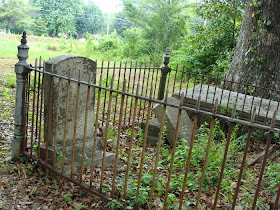When the Taliaferro family first came to America, they settled in Virginia. The land they arrived at was, at
the time, merely a British colony. By the point in the family’s history that
brings us to the generation in question for my current brick wall research
quandary, some of the family had removed to Georgia.
As I try to determine who my target person—Mary Taliaferro,
about to be wife of Thomas Firth Rainey in 1818—might have descended from, one
possible clue could come from examining who else
was married in the same Georgia county as she. Could the cluster of Taliaferro
weddings pinpoint the specific father of this bride?
According to the records accessible online now—and, granted,
these are only gleaned from indices on FamilySearch.org, though some digitized
records are accessible at Ancestry.com—there were four Taliaferro family
members who married in Oglethorpe County between the years 1809 and 1830. Who
were they? Who were their parents?
The earliest of the marriage records was for a “Lewis B. Talefaria” who wed Elizabeth Johnson on August 10, 1809. This was likely Louis
Bourbon, son of Martha Merriwether and Benjamin Taliaferro.
Louis’ father Benjamin was born in colonial Virginia, and came of
age during the years of the American Revolution, for which cause he served as a
lieutenant, and during which service he was promoted to captain.
After the war—and possibly owing to a falling out with his brother Zachariah
(of my direct line) over the hand of a particular young lady—Benjamin left Virginia for Georgia.
Benjamin’s arrival in Georgia, as it turned out, was
timely as well. He played an active part in the formative years of Georgia state
government. For his service during the thirty five years he lived in Georgia, Benjamin was posthumously honored by
the naming of a county in his memory—Taliaferro County. Though he was
noted to have died in Wilkes County, his oldest son’s marriage in Oglethorpe County—that
of Louis to Betsy Johnson—may well have taken place in the same basic area,
since Oglethorpe County
was formed from part of Wilkes County.
So we find, from this earliest Taliaferro marriage record in
the Oglethorpe vicinity, that it was a record referring to the eldest son of
Benjamin. What of the others?
Besides the 1818 marriage of Mary “Talafero”—whoever she was—the
next Taliaferro marriage in Oglethorpe
County was that of Polly
or Sarah “Taliferro.” She, as Sarah, was recorded as becoming the wife of one
Hay T. Landrum, according to the 1829 marriage entry. One of the old
genealogical publications I’ve referred to, compiled by Willie Catherine Ivey,
noted her as “Polly” and indicated that she “married a Mr. Landrum.” She—whether
Polly or Sarah—was daughter of Benjamin’s younger brother, Warren Taliaferro
(sometimes referred to in genealogies as Warner Taliaferro).
The final remaining Taliaferro wedding in Oglethorpe during
this time period was that of Charles, also a child of Warren Taliaferro. While
the marriage index shows his bride’s name as Milanda Meriwether, her name was apparently
Mildred Merriwether. This wedding followed close on the heels of Charles’
sister’s wedding—on November 16, 1830.
So, there you have it: four weddings. The earliest was for
the eldest son of the eldest Taliaferro brother to move from Virginia
to Georgia.
The last two, in 1829 and 1830, were for two of the children of the younger
Taliaferro brother. Could the remaining Taliaferro marriage in 1818 have been
for a child of either of those Taliaferro brothers?
According to Ivey’s Taliaferro genealogy, older brother
Benjamin’s youngest daughter was named Mary. However, younger brother Warren—though
not having any child named Mary that I can find—was married to a woman named
Mary Gilmer. Could it be possible that Warren and Mary named one of their
children Mary—but owing to the confusion of having two Marys in the same
household, resorted to the use of a nickname? Which of Warren and Mary’s
daughters would it be? The only one credited with marrying a Rainey in the Ivey
genealogy was listed as Nancy, not Mary. Is Nancy a nickname?
One other detail to consider: this Mary and her husband,
Thomas Firth Rainey, eventually had a son, whom they named Warren Taliaferro Rainey. While that seems like a flashing neon light pointing me in the right
direction, I’d like just a little more paper-based justification before I accept
what seems to be the obvious.
Above: "Signing the Register" by English painter Edmund Blair Leighton; courtesy Wikipedia; in the public domain.
Above: "Signing the Register" by English painter Edmund Blair Leighton; courtesy Wikipedia; in the public domain.






